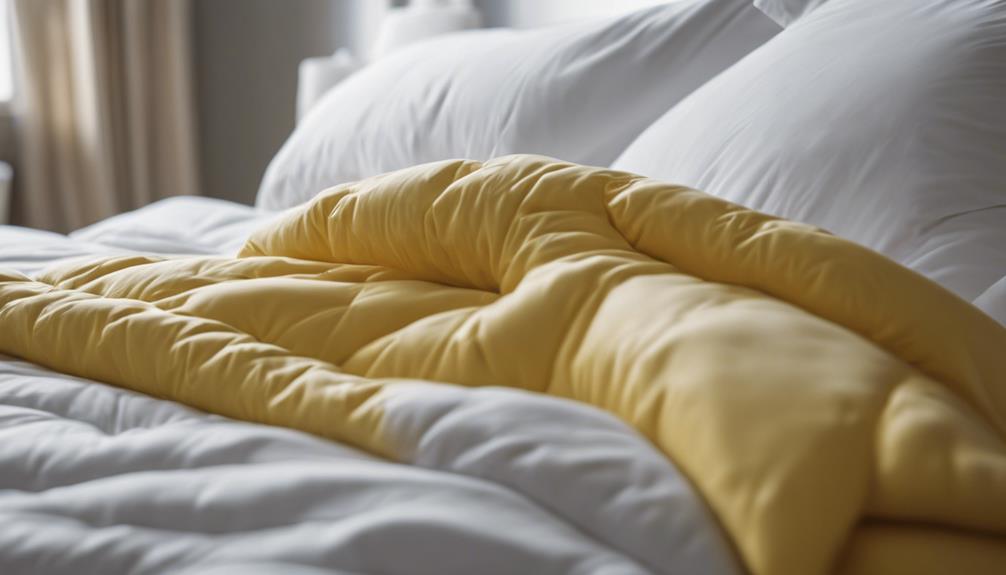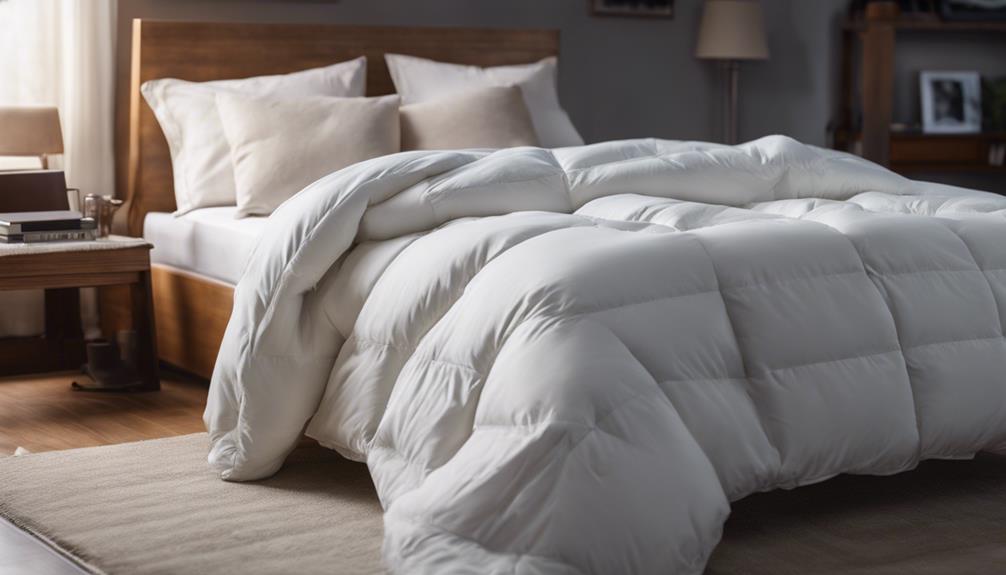When searching for ways to clean a down comforter, you have several options to choose from including local laundromats, specialized dry cleaners, bedding cleaning services, online solutions, and eco-friendly cleaners. These services provide expert care using specialized equipment, some of which employ eco-friendly practices. Home pickup and delivery companies offer convenience and fixed pricing for dry cleaning services with quick delivery. DIY cleaning suggestions recommend using gentle detergent and large machines, adding tennis balls for drying agitation, and considering a duvet cover to reduce the frequency of washings. To learn more about professional cleaning options for your down comforter, explore the various services available.
Key Takeaways
- Local laundromats offer expert cleaning services for down comforters.
- Dry cleaners specialize in cleaning down comforters safely and effectively.
- Specialty bedding cleaning services cater to delicate down comforters.
- Online down comforter cleaning services provide convenient solutions.
- Eco-friendly down comforter cleaners use sustainable practices for cleaning.
Local Laundromat With Professional Cleaning Services
When we need to freshen up our down comforter, our go-to choice is the local laundromat for professional cleaning services. The local laundromat offers expert cleaning services specifically tailored for down comforters. Instead of opting for dry cleaning, which can sometimes be harsh on delicate fabrics, professional laundering at the local laundromat is recommended to maintain the quality and fluffiness of your down comforter.
Choosing the local laundromat for cleaning your down comforter isn't only a cost-effective option but also guarantees thorough and effective results. The specialized equipment used by the professionals at the laundromat ensures that your comforter is cleaned with care and attention to detail. Before dropping off your down comforter at the local laundromat, be sure to inquire about their specific laundering services to make certain that your comforter receives the best treatment possible.
Trusting your down comforter to the experts at the local laundromat can help prolong its lifespan and keep it cozy and clean for many nights to come.
Dry Cleaner Specializing in Down Comforters
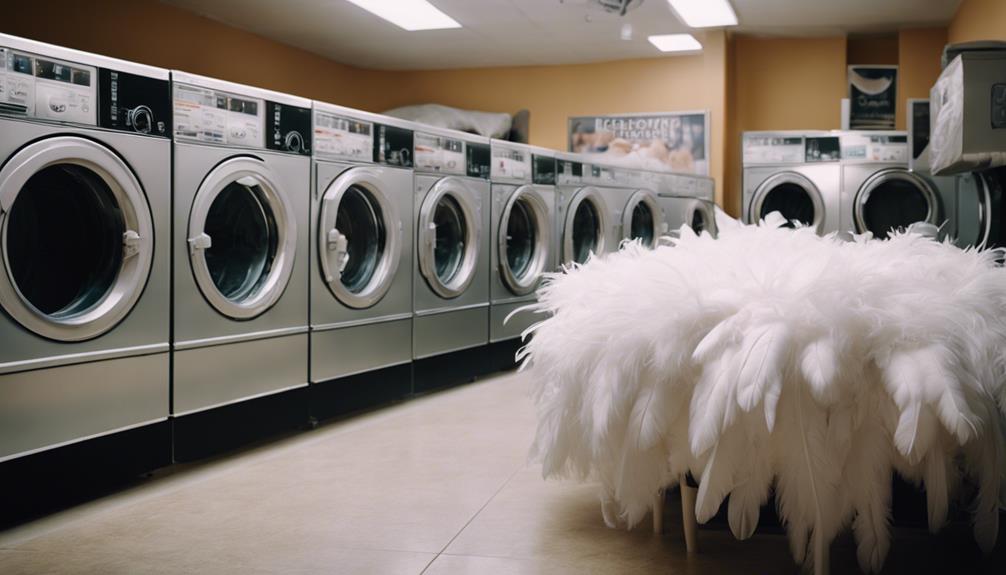
For those seeking specialized care for their down comforters, turning to a dry cleaner experienced in handling such delicate bedding is a wise choice. Specialized dry cleaners offer professional laundering services specifically designed for comforters. These dry cleaners understand the intricacies of down material and have the expertise to clean it effectively.
When considering dry cleaning your comforter, be aware that the cost can range from $30 to $50, depending on its size. Not all dry cleaners provide laundering services for comforters, so it's crucial to inquire beforehand to confirm they can accommodate your needs.
While dry cleaning can help prevent shrinkage, it's worth mentioning that the process may involve harsh chemicals that could potentially damage the down. To prolong the lifespan of your comforter, using a duvet cover can help reduce the frequency of washing. This simple step can extend the time between cleanings and keep your comforter in top condition for longer.
Specialty Bedding Cleaning Service

Specialty bedding cleaning services utilize expert cleaning techniques and professional equipment to guarantee outstanding cleanliness. They offer a range of services, including dry cleaning, pressing shirts, wash, fold, and area rug cleaning.
With next-day turnaround and convenient pickup and delivery options, these services provide exceptional care for all blankets and comforters.
Expert Cleaning Techniques
Our team employs advanced cleaning techniques tailored specifically for down comforters to guarantee exceptional cleanliness and maintenance.
When washing a down comforter, it's important to follow expert guidelines to ensure its longevity. Whether opting to have your comforter dry cleaned or using specialized cleaning methods at home, the key is to handle it with care.
Professional cleaning services understand the delicate nature of down comforters and use appropriate detergents and equipment to clean them effectively. By entrusting your down comforter to experts who know the ins and outs of proper cleaning techniques, you can rest assured that your bedding will be fresh, fluffy, and well-preserved for continued comfort and warmth.
Professional Equipment Used
We utilize industrial-sized washers and dryers in our specialty bedding cleaning service to effectively clean large items like down comforters. Our washing machines are equipped with gentle cycles to make sure that delicate down fill is treated with care. These high-capacity machines can accommodate the size of down comforters, allowing for a thorough cleaning process.
Additionally, our professional equipment includes specialized detergents and solvents formulated for delicate fabrics like down, guaranteeing a deep clean without damaging the material. With advanced equipment like steamers and pressers, we can effectively remove wrinkles and restore fluffiness to the comforter, maintaining its quality. Our goal is to provide safe and effective cleaning methods that preserve the loft, warmth, and longevity of down comforters.
Online Down Comforter Cleaning Services

When looking for a convenient and professional solution to clean your down comforter, online down comforter cleaning services offer a practical and efficient option. These services allow customers to schedule pick up and delivery of their comforters through online platforms, saving time and hassle.
Online down comforter cleaning services typically include thorough cleaning, drying, and fluffing to guarantee your comforter is fresh and cozy. Customers can easily access pricing details, turnaround times, and customer reviews on these platforms for transparency and peace of mind.
Whether your comforter needs dry cleaning or washing, online services cater to various cleaning needs. Some providers even offer eco-friendly cleaning options for those who prioritize sustainability. With the accessibility and professional care provided by online down comforter cleaning services, keeping your bedding clean and comfortable has never been easier.
Eco-Friendly Down Comforter Cleaners

When looking for down comforter cleaners, eco-friendly options stand out for their use of green cleaning methods and sustainable dry cleaning practices. These cleaners prioritize environmental impact reduction through non-toxic products and energy-efficient equipment.
Green Cleaning Methods
Utilizing innovative technologies like ozone treatment, eco-friendly down comforter cleaners prioritize sustainability by employing biodegradable detergents to minimize environmental impact. These cleaners use washing machines with mild detergents to clean down comforters effectively while reducing water and energy usage.
By opting for eco-friendly and non-toxic cleaning products, they guarantee a safe and environmentally friendly cleaning process. Some cleaners even offer hypoallergenic solutions for those with sensitivities. Green cleaning services may also utilize ozone treatment to sanitize down comforters without harsh chemicals.
Sustainable Dry Cleaning
To continue our discussion on eco-friendly down comforter cleaning methods, sustainable dry cleaning services prioritize the use of non-toxic solvents to minimize environmental impact. When opting for eco-friendly dry cleaning, consider the following:
- Utilization of eco-friendly and non-toxic solvents for cleaning down comforters.
- Emphasis on energy-efficient equipment and practices to reduce the carbon footprint.
- Offerings of biodegradable packaging and recycling options for a more sustainable approach.
- Support for businesses that focus on environmental responsibility through eco-friendly dry cleaning.
- Look for certifications like GreenEarth or Wet Cleaning to make sure sustainable practices are followed.
Hotel or Resort Laundry Services

Many hotels and resorts provide professional laundry services for guests, which include cleaning down comforters. Hotel laundry services are equipped with commercial-grade washers and dryers suitable for large items like comforters. Guests can easily request down comforter cleaning as part of their stay to guarantee cleanliness and freshness.
The staff at hotels are trained to handle delicate bedding materials like down comforters with care and expertise. Opting for hotel or resort laundry services for down comforter cleaning can save time and guarantee thorough cleaning results. It's a convenient solution for travelers looking to maintain their bedding during their stay without the hassle of seeking outside cleaning services.
Home Pickup and Delivery Cleaning Companies
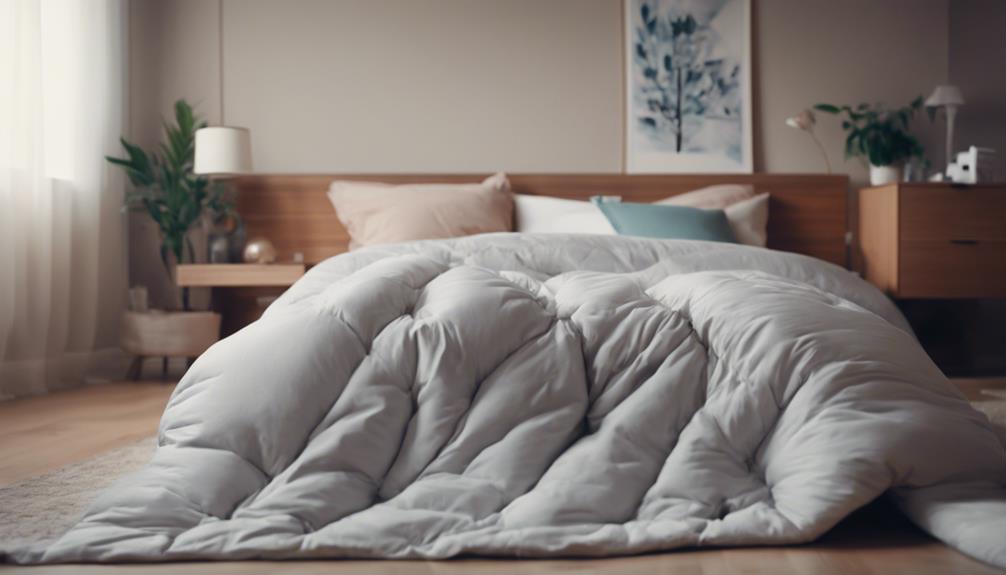
When considering down comforter cleaning options, one convenient choice is utilizing home pickup and delivery cleaning companies. These services offer the ease of having your down comforter cleaned right at your doorstep. Here are some key points to note about home pickup and delivery cleaning companies:
- Your down comforter can be cleaned for a fixed price of $24.99, regardless of its size.
- Next-day delivery is guaranteed with a turnaround time by 5 PM.
- Dry cleaning services are available for delicate comforters.
- Pressed shirts service can also be availed for added convenience.
- In addition to comforters, these companies offer wash and fold services, as well as area rug cleaning services.
With these companies, you can have your down comforter cleaned efficiently and professionally without the hassle of visiting a dry cleaner.
Dry Clean Delivery Services
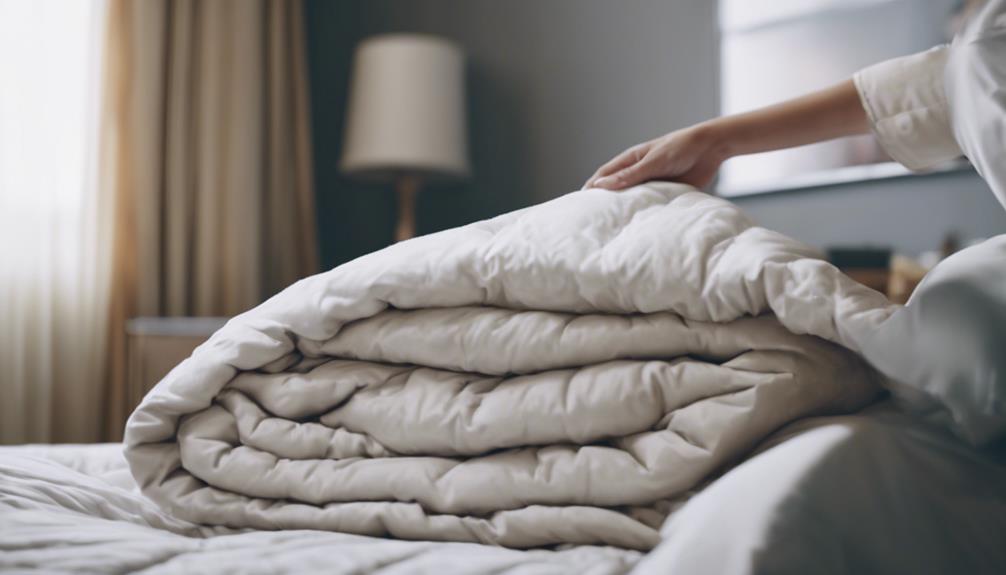
Moving from the convenience of home pickup and delivery cleaning companies, another efficient option worth exploring for down comforter cleaning is utilizing dry clean delivery services. These services offer a hassle-free solution by cleaning and delivering your bedding right to your doorstep.
One of the key advantages is the quick turnaround time, with next-day delivery guaranteed for dry cleaned items. Scheduling a pickup for your comforter cleaning needs is easy and can be done from the comfort of your home. Your bedding is professionally cleaned and then promptly delivered back to you, saving you valuable time and effort.
The convenience of accessing dry clean services from home with pickup and delivery options makes the process seamless and efficient. If you're looking for a convenient and reliable way to have your down comforter cleaned without leaving your home, dry clean delivery services are a great alternative worth exploring.
DIY Down Comforter Cleaning Tips
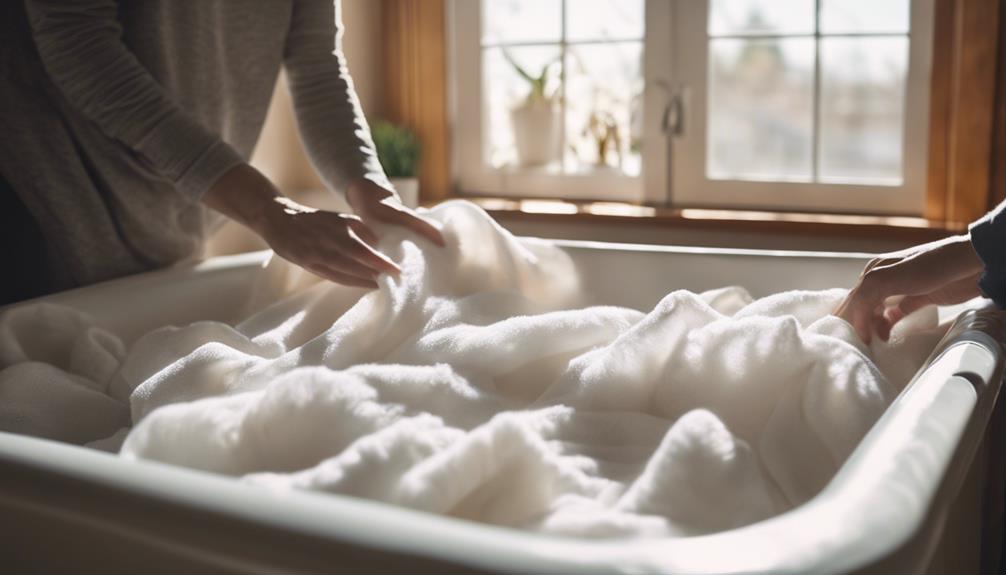
To effectively clean a down comforter at home, start by using a mild soap or detergent specifically formulated for washing down bedding. Here are some DIY down comforter cleaning tips:
- Use a mild soap or detergent designed for down comforters.
- Utilize the spin cycle in a large capacity washing machine for thorough cleaning.
- Dry the comforter thoroughly in a large dryer to prevent clumping and guarantee fluffiness.
- Agitate the comforter with clean tennis balls during drying to redistribute the down evenly.
- Consider using a duvet cover to reduce the frequency of washing the comforter.
Cleaning your down comforter at home can be a cost-effective and convenient option. By following these tips, you can maintain the quality and cleanliness of your comforter without the need for professional dry cleaning services. Remember to always check the care label on your comforter for specific instructions and recommendations to secure the best results.
Frequently Asked Questions
How Much Does It Cost to Clean a Down Comforter?
Cleaning a down comforter typically costs between $30 to $50, depending on its size and the chosen cleaning method. Dry cleaning can be around $30 to $50, with laundering services varying.
Some dry cleaners have a flat rate for all sizes. It's best to ask for the specific cost beforehand.
Can You Take a Down Comforter to the Dry Cleaners?
Yes, you can take a down comforter to the dry cleaners. Dry cleaning costs $30 to $50, depending on size. Not all dry cleaners offer this service, so ask first.
Dry cleaning can prevent shrinkage but may harm the down with harsh chemicals. Professional laundering is better for down quality.
Using a duvet cover can reduce how often you need to wash the comforter.
How Do You Wash a 100% Down Comforter?
We wash a 100% down comforter with mild detergent in a large front-loading washer. It's essential to use a gentle cycle to avoid damaging the delicate down material.
After washing, dry the comforter thoroughly in a large dryer on low heat settings. To fluff it up, toss in clean tennis balls during the drying process.
For less frequent washing, consider using a comforter cover to maintain cleanliness.
Is It OK to Wash a Down Comforter in the Washing Machine?
Yes, washing a down comforter in a large front-loading machine is generally safe if done correctly. Use mild detergent and warm water to prevent damage to the delicate down filling.
Always check the care tags and follow manufacturer's instructions for the best results. Avoid top-loading machines with agitators, as they can harm the comforter.
Proper washing techniques help maintain the loft and quality of the down comforter.
Can I Have My Old Down Comforter Cleaned or Should I Dispose of it?
If you’re debating whether to clean or dispose of your old down comforter, consider finding creative ways to repurpose old comforter instead. You can transform it into throw pillows, pet bedding, or even a DIY weighted blanket. Give your old comforter a new life instead of throwing it away.
Conclusion
To sum up, there are various options available for getting your down comforter cleaned, including:
- Local laundromats
- Dry cleaners
- Specialty bedding cleaning services
- Online cleaning services
While some may argue that cleaning a down comforter can be expensive, the benefits of having a clean and fresh comforter outweigh the cost. Consider the convenience and quality of professional cleaning services to guarantee your down comforter remains cozy and in top condition.



